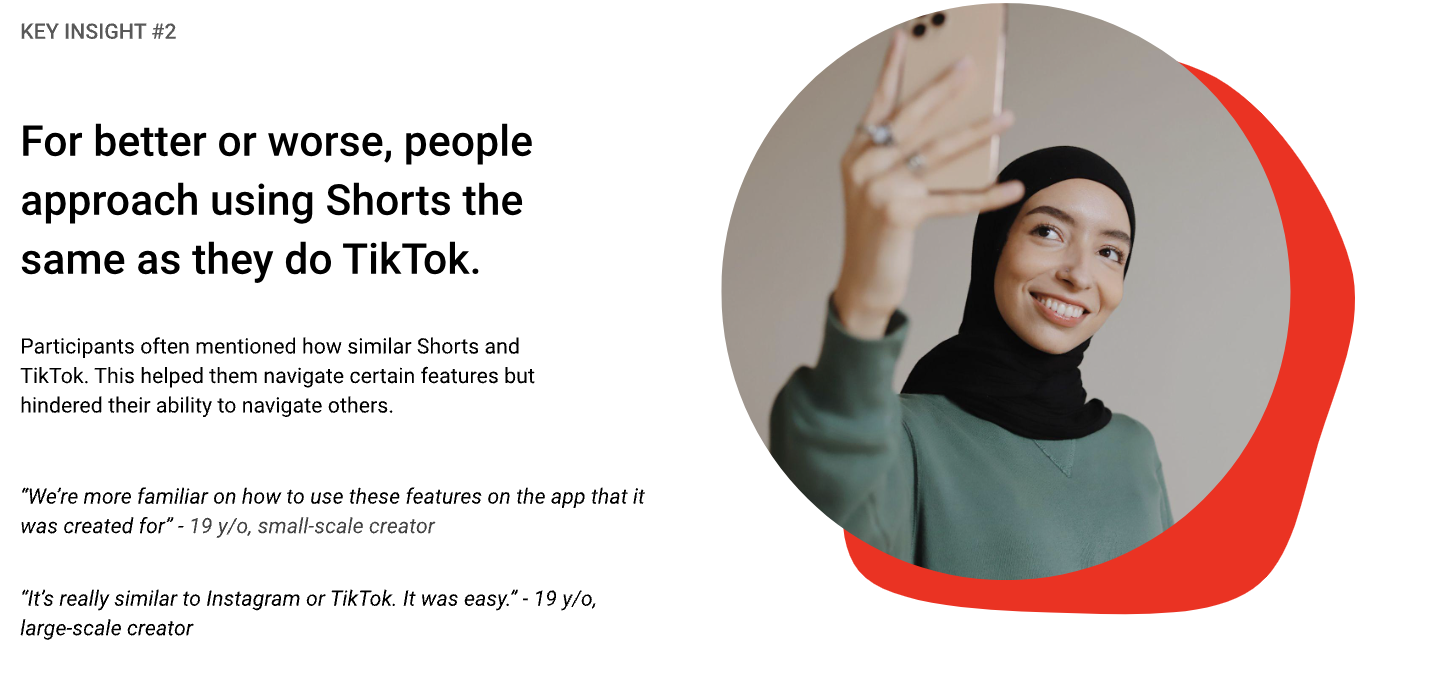YouTube Shorts UX Research Project
In 2022, I was a UI/UX Designer at Illinois Design Consulting, where my team was contracted by Senior UX Research Manager Silvia Vergani to conduct UX Research for the YouTube Shorts interface.
Role
As a UI/UX Designer, I worked closely with content creators and the YouTube UX team in conducting user studies. I identified key insights to develop a more intuitive user journey for content creators.
duration
January 2022 - December 2022
overview
Illinois Design Consulting was approached by YouTube’s design team to improve the user experience of Shorts by conducting usability research sessions with targeted groups.
The primary goal was to gain insights into the user experience of young creators. Working with the YouTube team and through several insightful conversations with creators, I got to hone my skills on relevant research methods.
Competitive Analysis
User Interviews
TEAM
UX Design
Sarah Chang, Ethan Igunbor, Gabriel Tan, Jabari Cooke, Skylar Atwell
TOOLS
Figma, Userzoom, Qualtrics, Miro
SCOPE
Initial Research, Competitive Analysis, User Interviews, Usability Testing, Journey Maps

Phase 1
Initial Research
To get started, our team first "vibed in" we used YouTube shorts daily and got to understand the platform and its position in the market. We then conducted a competitive analysis to figure out how Shorts compares to other short-format video apps.
Getting ready
After learning about the platform, we started preparing questions for the first round of interviews. While prepping, we looked for content creators on short-format video apps to recruit for our interviews. We looked to recruit a wide range of demographics and followings to give us the best understanding of the content creation process.
phase 2
Interviews
To gain a better understanding of a content creator’s perspective, we hosted 60-minute interview sessions that asked a series of questions that correlated to their experience with short-form videos. These interviews took the format of semi-structured interviews and we really got to understand what it takes to be a short-format video content creator.
Interview with Kashish Mehta from @The Foodie Bros
Debrief
We then debriefed our findings from Google Docs and qualtrics into a Miro Board to sort out key insights. We aimed to pull as many direct quotes to support our findings later in the process. These interviews help us accomplish our goal of understanding how people create short-format videos.
phase 3
usability testing
We then took our understanding of the content creation process to the next level of interviews. In this round, using the content creators we found in the recruitment process, we sought to conduct usability testing. We decided to implement the think-aloud protocol as a low-resource, high-feedback testing technique. In addition to that, our project manager conducted research and found a solution on how to implement hybrid in-person and virtual usability testing. Sarah discovered the company MailChimp using laptop hugging along with other large companies.
The use of laptop hugging allowed our project manager to see the usability testing from zoom as well as keep recordings for analyzing purposes. The participant would sit down and carry out the two tasks we provided, with limited guidance. Our two prompts were:
If I asked you to create a short, where would you first go to do that? Go ahead and navigate through the app. Next, upload a photo background (your choice) and record yourself explaining what the photo depicts.
1
rapid synthesis
Our team had been parallelly synthesizing and debriefing after each phase of the project. However, once the sessions were coming to a close, we held a rapid synthesis session to analyze what we had learned from the users. Plotting pain points, categorizing themes and topics, and going over each usability session helped us deconstruct the current short-form user experience.
Let’s say you have a favorite song and you want to use it as the background music for a YouTube Short. How would you go about doing that within the app?
2
pain points
Throughout the synthesis process, we found a lot of areas Shorts could improve upon. During the usability testing, we discovered pain points for the users during the creation process. We created a journey map to showcase the user's journey.
pain point 1: uploading a background
Given the first task of uploading an image using the green screen feature, users found it difficult to upload an image as a background. Users are used to uploading their own images via the bottom-left gallery square. This can be confusing because that square is only meant for uploading pre-existing videos to post as Shorts.
pain point 2: trimming music & video content
Users found it difficult to figure out how to trim content. Icons were often confusing, and finding the video trim feature wasn't apparent to users.
insights
After presenting our findings on the difficulties the content creators faced, we talked about possible opportunities and trends we saw within YouTube Shorts. We developed two key insights from our research within the semester.
takeaways
improved my interview skills
Through this project, I've sharpened my interview skills as well as my knowledge of usability testing techniques.
mapping out user flows
Collaborated with YouTube design team in synthesizing data and creating communicative maps of the user flow.
dont reinvent the wheel
Follow design standards. “X” on the top left of a browser will always mean close. YouTube Shorts confuses creators because it's very similar to TikTok but, more difficult to navigate due to the menu. That being said, content creators have to learn a new platform because the skills are not transferable. Creators will be unmotivated to learn the new platform and not utilize YouTube Shorts' recording and editing features. Instead, creators will be gravitated toward rehashing content from their TikTok to all other platforms, including YouTube Shorts. Our end goal is for users to instinctively know how to use an interface without much guidance. Great UX is UX you don’t notice.
Final thoughts
I had such a pleasure workng with my wonderful team and having the conversations I did. The entire experience seemed like a collection of insightful conversations with content creators that I got to call “research”. It was so incredibly rewarding to be able to present our findings to the Silvia Vergani and her team at YouTube.













